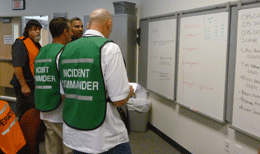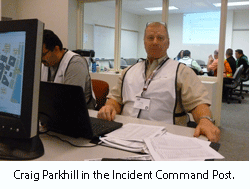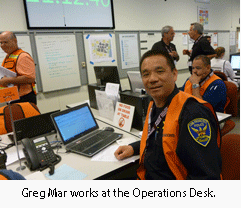Visit to ‘unluckiest place on earth’ prepares responders for incidents back home
COLLEGE STATION – It’s a typical day in Needland — the unluckiest place on earth. This morning, severe weather spawned an F3 tornado that struck a nine-block area of downtown, including the Bay View Convention Center. Injury and damage reports are sketchy and the Incident Command Post is in a frenzy of activity.
 At the Emergency Operations Training Center (aka Needland), 45 students are managing the large-scale disaster as part of a training scenario. The course is Enhanced All-Hazards Incident Management/Unified Command, recognized nationwide for its realistic, computer simulation-based scenarios that take students out of their comfort zone and prepare them for the real deal.
At the Emergency Operations Training Center (aka Needland), 45 students are managing the large-scale disaster as part of a training scenario. The course is Enhanced All-Hazards Incident Management/Unified Command, recognized nationwide for its realistic, computer simulation-based scenarios that take students out of their comfort zone and prepare them for the real deal.
The course is taught by the Texas A&M Engineering Extension Service (TEEX) and funded by DHS/FEMA through the Homeland Security National Training Program Cooperative Agreement. More than 6,500 emergency managers and responders from a wide variety of disciplines have completed the course since 2004.
 During this course, participants from 14 states and various disciplines are working together within teams in the Incident Command Post in College Station. Their backgrounds include not only law enforcement, the fire service and emergency management, but also the military, government administration, public health and transportation security. And many of the participants especially value the training because of their real-world experiences.
During this course, participants from 14 states and various disciplines are working together within teams in the Incident Command Post in College Station. Their backgrounds include not only law enforcement, the fire service and emergency management, but also the military, government administration, public health and transportation security. And many of the participants especially value the training because of their real-world experiences.
Craig Parkhill, CEM, who serves as DSCA Coordinator for the Texas Military Forces 136th MEB (Homeland Response Force), resides in Wimberley, which was struck by catastrophic flooding along the Blanco River in May.
“Training of this type is vitally important,” he says. “The Texas Military Forces sent people to Wimberley for search and rescue and debris cleanup. When something happens, it’s too late to train for it. We saw that in Wimberley. No one expected the river to flood since we were still in a drought.”
“This is an excellent course,” he added. “I already feel I’m more prepared to be a more productive member of the team.”
 Lt. Greg Mar, with the San Francisco Police Department, is assigned to the San Francisco International Airport (SFO) and was on duty when Asiana flight 214 crashed in July 2013.
Lt. Greg Mar, with the San Francisco Police Department, is assigned to the San Francisco International Airport (SFO) and was on duty when Asiana flight 214 crashed in July 2013.
“If you have done training like this before (an incident), you feel more comfortable in a real situation,” he says. “This helps put everything into perspective. The online (incident command) training provides basic information, but this helps you to visualize how it works. It makes more sense when you do these exercises. It helps you put things together and learn why certain things happen.
“We rotate through various roles and get a different perspective,” Mar added. “You are not afraid to make mistakes here because you are not dealing with real people; this is more like virtual reality. You get experience without the real deal.”
 Capt. Chuck French, Training and Safety Officer for Nacogdoches Fire and Rescue, is part of the Piney Woods Incident Management Team (IMT), which has recognized the value of this training. “We are trying to send the entire team to experience the dynamics of this course,” he said. He is the eighth member to attend.
Capt. Chuck French, Training and Safety Officer for Nacogdoches Fire and Rescue, is part of the Piney Woods Incident Management Team (IMT), which has recognized the value of this training. “We are trying to send the entire team to experience the dynamics of this course,” he said. He is the eighth member to attend.
He said his local EOC was stood up for a flood event just a few days before he arrived in College Station, and the EOC was also activated for the Angelina River Bottom Fire of 2011, which charred 6,554 acres.
“This is a great course, with a great group of instructors and a very functional command post,” he added. “Working in different positions, you get to see what other positions are required to complete. That’s a benefit of this training.”
Learn more about the Emergency Operations Training Center at TEEX.
